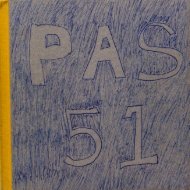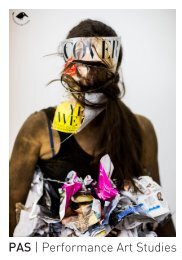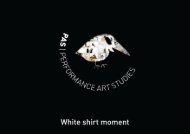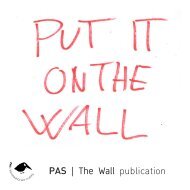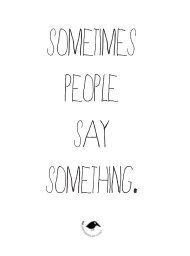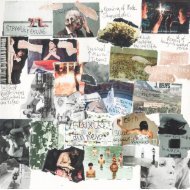PAS | honey for the mind
"honey for the mind", process publication of PAS | Performance Art Studies #66 "if I were in your place", 546 pages, published by PAS 2019 PAS #66 "if I were in your place" was realized in cooperation with Karstica - Espacio de Creacion, Cañada del Hoyo and Museo Neomudejar, Madrid 15. - 22. September 2019. with contributions by John Muse, Karoline Strys, Ana Reis, Berendine Venemans, Lili Ullrich, Brendamaris Rodriguez, María Herrador, Debbie Reda, Monika Deimling, BBB Johannes Deimling.
"honey for the mind", process publication of PAS | Performance Art Studies #66 "if I were in your place", 546 pages, published by PAS 2019
PAS #66 "if I were in your place" was realized in cooperation with Karstica - Espacio de Creacion, Cañada del Hoyo and Museo Neomudejar, Madrid 15. - 22. September 2019.
with contributions by John Muse, Karoline Strys, Ana Reis, Berendine Venemans, Lili Ullrich, Brendamaris Rodriguez, María Herrador, Debbie Reda, Monika Deimling, BBB Johannes Deimling.
You also want an ePaper? Increase the reach of your titles
YUMPU automatically turns print PDFs into web optimized ePapers that Google loves.
PAS | Performance Art Studies #66
“If I were in your place”
process documentation
PAS | Performance Art Studies
“There is not one way of doing performance art,
but many.”
PAS | Performance Art Studies was created in January 2008 with the
interest of establishing a platform for artistic and social dialogue in
order to shape a space for constant, critical learning and exploration
its inexhaustible potential between Performance Art and other art
genres. The studies consist of gatherings of people, who are interested
in sharing experiences, view points and visions in which collective,
artistic experiments are made and widen the perspective and
perception through participation and sharing. The process-based experiments
are learning tools for sharpening ones view on the world
and questioning our role as humans and creative workers.
Since Performance Art constantly expands and develops, there remains
a huge field of unknown and undiscovered territory, which
could offer solutions for artistic and non-artistic research, production
and reflection. Stating this means: the main learning tool within
a PAS study is the process of which we are uncertain where it will
lead us. This process is directed to all involved without restrictions
and mainly guided by the agreed experiments. This openness towards
the PAS process implies the logic that each and every one involved is
using his or hers potential to sculpt the space in which we are learning,
exploring and creating. Aiming beyond the question ‘How do we
create a performance art piece?’ is the soul of PAS process.
The main source of a Performance work is the present body of a person
who presents an artistic concept in front of a present audience
in space and time. Therefore PAS understands Performance Art as a
social art form and embraces diversity of those involved in its artistic
processes. Skin color, age, gender, religion, political stance, social
or cultural backgrounds are understood as qualities, and as tools to
generate intersections where learning actually happens. The differences
are treated equally and thought of as artistic formulas like color,
shape, size, body, space, time, materials, which are the subjects of
our artistic endeavors. This is essentially needed since the occurring
intersections between humans, forms, opinions and artistic visions
provide the potential to touch the unknown and create something that
we would be unable to discover on our own. During this vivid process
we constantly inspire, demand and challenge ourselves as a crucial
deed for changing perspective and allowing content of others to be
displayed. This, then could adapt or integrate within our working processes
and attitudes. The collective learning pool has a very legible
aim: the ‘I’ needs to transform into a unique readable sign, which addresses
the other in order to start a dialogue.
Collective learning pools
PAS consists of a dedicated and passionate team of educators and
artists who support the idea that ‘there is not one way of doing Performance
Art, but many’. Each PAS study features one or two guest
teachers, who offer unique perspectives of the study topics and share
previously made experiences.
The PAS studies are collective learning pools, designed to explore,
research and examine within the vast field of Art, especially Performance
Art and connecting these outcomes to social, political and
cultural issues. Each study suits a specific topic based on questions
raised by historical and contemporary theories and practices. The
choice of the study topic can also be influenced by the place and the
context where PAS is happening. The process is directed toward the
creation of an individual or collaborative performance, which is presented
during a public event. Furthermore, it points to a deviation of
former individual and collective working methods and structures.
We are aiming to change how performance art has been produced and
conceptualized over time. As with all mediums, Performance Art can
find itself stuck in repetition of materials, attitudes and styles if learning
focusses only on the historical and contemporary working methods.
To avoid a hermetic learning process, we incorporate, whenever
possible, other art forms (sculpture, painting, video, sound, photog-
raphy, poetry, dance, architecture, theatre, activism, etc.), as well as
supporting theories from science, philosophy, politics and wide array
of other fields. This inclusion model reaches beyond the status quo
and helps to keep the process vivid and open.
The PAS studies are mainly practical work sessions, in which performative
experiments and questions are tested and shared amongst
the participants. We use experiments, exercises, tasks, games, assignments
and ‘homework’ to widen the pallet of perception, awareness
and learning. Parallel, we offer direct reflections and analyses of
made experiences. Discussions, feedback, storytelling, drawing, writing
and documentation are constant companions of the practical work
that are specifically selected to fit the research topic.
BBB Johannes Deimling
artistic director and founder of PAS | Performance Art Studies
PAS #66 | “if I were in your place”
“If you work site-specific, you need to be very specific with the site”
(BBB Johannes Deimling)
The term site-specific describes artistic production in close relation
with a physical site. Since its appearance in performance the term
“site-specific performance” has influenced and inspired performance
art practice and theory.
One could state that each performance work is site-specific since
it is always happening in a spatial context and corresponding in
one way or the other with the surrounding in which it appears. This
thought is supported by the fact that our human body is not able to
leave space since it surrounds us the moment we start growing in
the uterus.
But the term “site-specific” describes not only a form or state of being
but more a working method, a research practice which resonates
in so many fields alongside the arts: ecology, humanity, history, politics,
time, etc. The spatial context, the site-specific aspect of artistic
production, presentation and perception is a reservoir of diverse and
– it seems – endless artistic potential to create site related artworks.
CONCEPT
We can expand the present space, site or place and transform into
collaborative work with our perspectives and ideas. But at the same
time the site offers us its perspectives and access points to its given
structures, forms and aesthetics. In order to balance the individual
artistic concept with the given or chosen site, the need for precise research
and dialogue is inevitable. The site has the power to crush any
artistic idea with ease.
PAS | #66 “if I were in your place” will focus on the possibilities of
site-specific aspects in performance practices and theory. For this,
we chose a rural place in Spain, away from urban cities and marked
by a very unique (Jurassic) landscape between Valencia and Madrid:
Cañada del Hoyo (click here to see where it is located). Besides the
beauty and the possibilities of the landscape we also want to include
the knowledge and the culture of the inhabitants of the nearby village.
This will create a vibrant and deep site-specific research which we
aim to connect with our views we bring to the place in order to create
a dynamic artistic dialogue.
BBB Johannes Deimling, 2019
PAS #66 | THE WALL
Starting from the first meeting to the goodbye moment at the end we
undergo an intensive, vivid artistic and mainly experimental process.
Including various research settings, exercises, games, tasks and assignments
we test different aspects of performance art. The process
is rich in its researches, ideas, philosophies and questions. The often
pure and raw artistic process is the base on which performance art
concepts are developed and executed. It contains knowledge which
goes beyond the actual artistic work and inspires other nonartistic
fields. PAS is working very much with the concept of an unrehearsed
artistic action. The focus is pointed on the 'unidentified', the ‘unknown’.
How to preserve this collective gathered knowledge which is the
source of this process and its results? ‘THE WALL’ provides a form,
similar to a notebook, as an uncensored space in which thoughts,
statements, feelings, questions, drawings, writings and pictures are
displayed throughout the whole studies. It is an open and shared
platform and with its performative charm ‘THE WALL’ offers the view
on connections and intersections throughout the whole process. It
is possible to use this tool as a reminder or memory during different
stages of the process. In case of getting lost, or stuck, or confused
‘THE WALL’ helps to find another path to continue the artistic endeavor.
Everybody is responsible to enrich ‘THE WALL’ with his or hers
comments on the running process. The constant collected documents
offer each day orientation on how we got until this point and supports
the reflection as a motor of the learning process. Furthermore it
opens the view on the particular free spaces and areas which are not
discovered yet.
This part of the publication documents ‘THE WALL’ which was created
during PAS #66 by John Muse, Karoline Strys, Ana Reis, Berendine
Venemans, Lili Ullrich, Brendamaris Rodriguez, María Herrador, Debbie
Reda, Monika Deimling, BBB Johannes Deimling.
Berendine Venemans
“phototask”
María Herrador
“phototask”
Karoline Strys
“phototask”
Ana Reis
“phototask”
Brendamaris Rodriguez
“phototask”
Lili Ullrich
“phototask”
Debbie Reda & John Muse
“phototask”
Debbie Reda
& John Muse
“phototask”
Brendamaris Rodriguez & Lili Ullrich
“phototask”
Brendamaris Rodriguez
“word & action”
Berendine Venemans
“word & action”
Debbie Reda
“word & action”
María Herrador
“word & action”
Lili Ullrich
“word & action”
Karoline Strys
“word & action”
Ana Reis
“word & action”
John Muse
“word & action”
watch “THE BAND”
by scanning the QR code
or visit: https://vimeo.com/364264208
Karoline Strys & John Muse
“Duo”
Karoline Strys & John Muse
“Duo”
Debbie Reda & Brendamaris Rodriguez
“Duo”
Debbie Reda & Brendamaris Rodriguez
“Duo”
Lili Ullrich & María Herrador
“Duo”
Lili Ullrich & María Herrador
“Duo”
Ana Reis & Berendine Venemans - “Duo”
Ana Reis & Berendine Venemans
“Duo”
María Herrador
“phototask”
Lili Ullrich
“phototask”
Karoline Strys
“phototask”
Brendamaris Rodriguez
“phototask”
Debbie Reda
“phototask”
Berendine Venemans
“phototask”
John Muse
“phototask”
Ana Reis
“phototask”
BBB Johannes Deimling
“phototask”
Monika Deimling
during the “phototask”
watch the PAS | “sculpture park”
by scanning the QR code
or visit: https://vimeo.com/365156517
Brendamaris Rodriguez
“singing and dancing”
Lili Ullrich
“singing and dancing”
Ana Reis
“singing and dancing”
Karoline Strys
“singing and dancing”
Berendine Venemans
“singing and dancing”
María Herrador
“singing and dancing”
John Muse
“singing and dancing”
Debbie Reda
“singing and dancing”
Maria for Brendamaris
“From Me To You”
Ana for Debbie
“From Me To You”
Brendamaris for Berendine
“From Me To You”
Berendine for Lili
“From Me To You”
Lili for John
“From Me To You”
Lili for John
“From Me To You”
Debbie for Karoline
“From Me To You”
Debbie for Karoline
“From Me To You”
John for Ana
“From Me To You”
Karoline for Maria
“From Me To You”
PAS | white shirt moment
The public presentation of performances is another task and a highlight
within the PAS process. Until this point, we have presented the
performance tasks in a safe research environment to the other participants
of the studies in order to understand how performance concepts
are resonating. This process is now open to the public whom
we invite to an evening of performances. The creative act in front
of an audience is a precious moment for all involved: it is what PAS
calls the ‘White Shirt Moment’.
During the studies we undergo an intense and vivid artistic research
process which is filled with questions and experiments pointing on
many aspects of performance practice and theory. It is the time
where ideas are raw, actions are more intuitive and not ‘ready yet’,
when material choices are pure, and experimentation is the main
tool of artistic articulation. In this sate of the process a lot of valuable
questions are raised which have the potential to find an entrance into
one’s own approach towards performance art. The shared research
space is wide open and supported by discussions and reflections
where choices can be made on what to follow up for the public presentation
of an individual performance artwork.
Performance Art is a social art form since the connection between
performer and audience is crucial to its appearance and impact. Within
the intersection of presenting the performance and watching it, lays
one of the most important moments within performance art practice.
The performer is creating a different kind of reality for the audience
and by its presence the audience is shaping a different reality for the
performer. In this interaction a visual dialogue will appear in which we
create something new together.
This to experience is one goal of the task. After the moment of public
performance, we will find answers on some questions that have occurred
during the process, but we will also gain new questions on that
what we have presented. This is a state where we will realize that the
process is a constant part of performance art practice which doesn’t
end with the presentation, but mainly starts from there.
BBB Johannes Deimling, 2019
Ana Reis
El viento_blow in the Wind_Avoa Duration: 8 minutes
The space of the residence was the old train station of the little village.
The room i was sleeping had a balcon where you could see the
train passing and a green field in the mountains. I asked to the public
to go upstairs and stay in the balcon. When they were all together in
this place, kids and adults, local people with the residency artists, i
came out from behind a tree in the midlle of the field. I start to throw
a red sheet in the air, it goes up and down. My walk is guide from a
wish to go to a place and the movements of the wind, blowind the
sheet in other directions. Each time the red sheet flies and fall in the
floor, it makes a diferent shape and movement. Walking from far to
close, sometimes i disapper in the montain and people could only
see the red flying in the midlle of the green. I make this way until
get in a point where i have left my wings, made from tree branches.
I wear the wings and start to round and spin around myself, going
down in the field.
I want to fly, i want to blow in the wind. Ser viento, volar, voar, soprar
como corpo cor, corpo asa. Avoa cor avoa passarinho.
Brendamaris Rodriguez
Invisible war Duration: 15 minutes
Performance art, natural landscape to create site specific structures,
art forms with natural and industry materials like sculpture a
performance of invisibility to see how we are invisible of seeing that
we are part of nature and it is impossible to be something disconnected
from it. Therefore, its destruction leads us to drag our consequences.
Debbie Reda
Circunsferencia Duration: 25 minutes
Doing circles from outside to inside, covering and marking the space
(in the air, od the floor and windows)
What or where is the centre? that space that human being always try
to find.
Circular movements, the return to the beginning, action and repetition.
Using the performatic aspect as a way to focus on being and belong
to. Circle as a center. Center as the relation between body and presence,
time and space.
María Herrador
Borriquera Duration: 11 minutes
I enter with a crown of thistles.
I walk through space with small steps. Turn. I’m still walking. When I
floor a puddle of water I stop there. I tap the water. I´m still walking.
And I repeat the actions.
I take off my crown and leave it on the floor.
I move and go to a thistle that is in a corner. I take the thistle. Kiss
the thistle. I leave the thistle.
I move and go to another thistle from the other corner. I take some
stones. I throw stones at the thistle. When it falls I pick it up. I carry
the thistle with my hands as a bed. I put it in a puddle of water. I bury
it with water.
I go to another puddle of water. I wash my hands. I’m leaving the
room.
The thistle talks about my country. Thistle grows in the gutters. The
thistle is suffering and faith.
Look at what you don’t see and see from there everything else.
Be and live the material. Be the site and the support.
The beauty of the underrated.
Performance becomes a game of form and use of thistle. A search to
evoke and transmit my own poetic and referential perceptions of it.
Berendine Venemans
HELLO? IS IT YOU I’M SMELLING FOR?
Duration: 7 minutes
Material: Locally harvested Rosemary
A land has its aromas. A people has its culture and history. Aroma
and history are indefinitely intertwined. Smell can sometimes access
deeper seemingly forgotten memories.
This performance researches how to rekindle the dialogue between
memories, cultural and historical values through the release of its
aroma.
When you enter the room, I already sit on a log, a pile of Rosemary
laying beside me. Both, we wait. A while.
Then, when you don’t expect it, I take a small pestle and mortar from
out of the pile, put small branches in and start pounding it.
Rhythmically pounding. Add more branches, pounding, releasing the
aroma.
The log I sit on is next in line; I put the pestle and mortar aside, get
up, get bigger branches, take the log and start pounding them, too.
Rhythmically pounding. But this still seems not enough.
Getting up, start rubbing branches together. This seems better in releasing
the smell.
Then, I see how I can rub more branches; rub the walls. Still not
enough. Incorporate with body: put branches in my trousers, rub myself
against the walls.
Jumping up and down. More.
Take more branches and while rubbing, I start hitting the walls with
branches. Pound the floor, rub the floor, bigger motions, quicker motions.
Take the log again, roll the log, rub the log, hit with log. Crescendo of
movements while I rub gradually more Rosemary on the floor, using
my whole body,
dig through the Rosemary, crawl and roll and wriggle through the
Rosemary: continuing crescendo.
Until, lying flat on the floor I grab all the branches with only my hands,
gather them together and build myself a bed.
Lie down, it is done.
Get up, grab a branch, approach the audience and offer them a small
piece which I bury in their hands.
Karolina Strys & John Muse
Where They Belong Duration: 15 minutes
Two people struggle to climb through the windows of a car parked
in an otherwise deserted rural landscape. They finally succeed and
then return a trunk load of rocks, rubble, sticks, and bricks to their
proper places. One person walks off. The other tries to drive off, but
the car won’t start and so walks off as well.
The work was prompted by the contrast between the car--a contemporary
technical object--and the landscape, which is both natural but
also a ruin, strewn with rubble and gravel. The people are at home
neither in the car nor in that very lndscape, and so they labor to get
in, get out, restore things, leave.
Ana Reis
Dripping and dripping, uma a uma, gota a gota
Duration: 10 minutes
The house was old with a high ceiling. In the midlle of the living room
a drip falling down every day. We get used to this drip, insert it in our
daily life, our investigations and performances. The water was present
all the time, making this sound echos into the house, highered
for the silence of the nights. We were a lot of womens being together
for many days. Many of them started to menstruate together. I also
menstruate with them and in some moments i felt a lot of blood dripping
out from me. In the performance i taked out my clothes and get
naked. I put my body under the dripping with the legs up. The drips
starts to reach my body, coming down in my legs and in some times
reaching my vagina. The drips of water meet the drips of blood in the
between the inside and the outside of my body. An encounter in the
border. After same time lefting the drips walk in my body, i start to
drag in the floor. My wet body let a trace in the space. I drag until
the end of the room, get up, look to the traces and leave, going upstairs
to put my clothes. When i get in the second floor the blood drip
and drip on the ground. Nobody see it. I can see. Dripping and dripping.
Goteira, gotejamento, água que escorre, sangue que pinga, de dentro
de mim, de dentro da casa. El goteo de agua, el goteo de sangre en mi
cuerpo, mojando la casa.
Lili Ullrich
huecos profundos Duration: 6 minutes
While a video projects onto my body, showing a site specific performance
at the Laguna del Tejo in Cañada del Hoyo, I move through the
projection in slow motion. As in the video, my T-shirt is pulled of my
head and stretching the white fabric with my hands, I create a round
hole (hueco) out of my collar. Through this I explore my surroundings,
the round opening framing my view, while I move my upper
body in circular movements.
‘huecos profundos’ explores the lagoons of Cañada del Hoyo, specifically
the Laguna del Tejo with a depth of 32 meters.
Exploring the site of a deep water hole through new media and physical
movement, my T-shirt becomes a metaphor for the mysteriousness
and spiritual connection with nature, defining the identity of the
little village of Cañada del Hoyo.
Allí DONDE ESTUVIMOS
31 de octubre, 2019, Madrid
Museo La Neomudejar. Madrid
PAS #66. Performance Art Studies
PAS / Performance Art Studies, fue creada en el 2008 por el artista alemán BBB Johannes Deimling,
como un espacio para el dialogo artístico y social durante el aprendizaje y exploración de las artes escénicas.
Compartiendo experiencias y puntos de vista, realizando experimentos artísticos y ampliando
la percepción a través de la participación y el intercambio, cuestionando nuestro papel como humanos y
trabajadores creativos.
La fuente principal de un trabajo de performance es el cuerpo de una persona que presenta un concepto
artístico frente a una audiencia presente en el espacio y el tiempo. Por lo tanto, PAS entiende la performance
como una forma de arte social que abarca la diversidad de aquellos involucrados en sus procesos
artísticos.
La edición de PAS número 66, fue realizada en España, en Cañada del Hoyo, Cuenca, el último mes de
septiembre del corriente año, en la residencia artística Kárstica con el título “If I were in your place” (Si
estuviera en tu lugar). PAS #66 dio lugar a una serie de ejercicios con relación a la poética del espacio,
centrada en el concepto del “site-specific” y el diálogo con el paisaje rural del entorno.
Un grupo de ocho artistas de diferentes partes del mundo como Alemania, Argentina, Brasil, España,
Estados Unidos, Holanda y Puerto Rico, dieron lugar a una investigación que conectó diferentes sensibilidades
en un dialogo dinámico con el espacio. Entendiendo también el cuerpo como lugar habitable, en
relación con diversos materiales del entorno, como la luz, el viento, el sonido, el tiempo, la arquitectura y
la naturaleza. Interactuando, experimentando, desplazándose y fusionándose con el contexto, generando
una arqueología de rastros, huellas, intercambios y capturas, transformadas y reinventadas en acciones,
performances, videos y registros fotográficos.
Continuando con el trabajo “site specific”, nos hemos planteado el desafío de hacer expansiva la experiencia,
adaptando las performances realizadas en el entorno rural de Cañada del Hoyo a la sala del Museo
La Neomudéjar de Madrid.
“Allí donde estuvimos” es esta reinterpretación donde, una vez más, el cuerpo, los materiales, el tiempo
y el espacio, se unen en un todo para dar lugar a una nueva experiencia visual.
Se presentarán una serie de proyecciones de algunos de los trabajos realizados en la residencia artística
Kárstica durante la edición de PAS #66 y luego se podrán ver los nuevos proyectos, algunos en formato
documentado en video y otras presentaciones en vivo con nuevas performances.
Os invitamos a conocer a los artistas participantes:
Ana Reis (Brasil), Berendine Venemans (Holanda), Brendamaris Rodríguez (Puerto Rico), Debbie Reda
(Argentina), John Muse (Estados Unidos), Karolina Stryz (Alemania), Lili Ullrich (Alemania/Colombia) y
María Herrador (España).
PAS | Imprint
“Honey for the mind”
Process publication
PAS | Performance Art Studies #66 | “if I were in your place”
15. - 22. September 2019, Cañada del Hoyo, Spain
Published by PAS | Performance Art Studies 2019
546 pages
All texts, drawings, notes © by the authors: John Muse, Karoline
Strys, Ana Reis, Berendine Venemans, Lili Ullrich, Brendamaris Rodriguez,
María Herrador, Debbie Reda, Monika Deimling, BBB Johannes
Deimling.
All concepts of performances © by the authors: John Muse, Karoline
Strys, Ana Reis, Berendine Venemans, Lili Ullrich, Brendamaris Rodriguez,
María Herrador, Debbie Reda.
All photos in this publication © by Monika Deimling 2019
except page 526 - 527 and 510 -511 photos © by John Muse 2019
and page 253 photo © by BBB Johannes Deimling
layout: BBB Johannes Deimling
PAS #66 poster image: Blendi Shahu (PAS # 63, Tirana, Albania) photo
by Monika Deimling
PAS #66 is a cooperation with Karstica - Espacio de Creacion, Cañada
del Hoyo and Museo Neomudejar, Madrid
PAS | Performance Art Studies, founded in 2008 by German artist and pedagogue
BBB Johannes Deimling, is an independent educational program that is offering
intensive studies to people interested in performance art since 2008. The aim of
the studies is to provide the participants with a comprehensive form of learning
and teaching in process on performance art. The courses are practical and
theoretical research studies examining performance production, perception
and documentation.
Contact
web: pas.bbbjohannesdeimling.de
email: pas@bbbjohannesdeimling.de
instagram: instagram.com/performance_art_studies
facebook: facebook.com/PASperformanceartstudies
vimeo: vimeo.com/performanceartstudies
BBB Johannes Deimling
artistic director and founder
Monika Deimling
photographer, critical advisor
PAS | Studies since 2008
#69 | “it’s not the action that makes the performance” / Valencia, Spain 2019
#68 | “CREAKING WOODEN FISH” / Oslo, Norway 2019
#67 | “course of action” / Groningen, Netherlands 2019
#66 | “if I were in your place” / Cañada del Hoyo, Spain 2019
#65 | “your perception may not be my reality” / Berlin, Germany 2019
#64 | “between the lines #11” / Rehlovice, Czechia 2019
#63 | “course of action” / Tirana, Albania 2019
#62 | “course of action” / Tallinn, Estonia 2019
#61 | “there is not one way of doing performance, but many” / Utrecht, Netherlands 2019
#60 | “aging as an action” / Oslo, Norway 2018
#59 | “between the lines #11” / Rehlovice, Czechia 2018
#58 | “my body asking your body questions” / Oslo, Norway 2017
#57 | “ALONG AND THROUGH - how to walk a line” / Paris, France 2017
#56 | “between the lines #10” / Rehlovice, Czech Republic 2017
#55 | “DUEL” / The Hague, Netherlands 2017
#54 | “Na granicy percepcji rosna wspaniale kwiaty” / Lódz, Poland 2017
#53 | “IN-DUST-REAL” / Bat Yam, Israel 2017
#52 | “Zeitgeist” / Utrecht, Netherlands 2017
#51 | “critical reflection II” / Venice, Italy 2016
#50 | “roots in motion” / Oslo, Norway 2016
#49 | “Neighbourhood” / Bratislava, Slovakia 2016
#48 | “between the lines 9” / Rehlovice, Czech Republic 2016
#47 | “ICON” / Vienna, Austria 2016
#46 | “.doc” / Fredrikstad, Norway 2016
#45 | “Human Factor #2” / Tallinn, Estonia 2016
#44 | “I know the smell, but I don’t remember” / Poznan, Poland 2015
#43 | “Places of duration #2” / Fredrikstad, Norway 2015
#42 | “Salt & Pepper” / Oslo, Norway 2015
#41 | “between the lines 8” / Rehlovice, Czech Republic 2015
#40 | “human factor” / Poznan, Poland 2015
#39 | “creaking wooden fish” / Venice, Italy 2015
#38 | “places of duration” / Athens, Greece 2015
#37 | “critical reflection” / Venice, Italy 2014
#36 | “between the lines 7” / Rehlovice, Czech Republic 2014
#35 | “Resistance” / Kaunas, Lithuania 2014
#34 | “Alphabet 2” / Fredrikstad, Norway 2013
#33 | “squaremeters per hour (territory)” / Oslo, Norway 2013
#32 | “Absurdity” / Berlin, Germany 2013
#31 | “between the lines 6” / Rehlovice, Czech Republic 2013
#30 | “The moment when the end surprises the beginning” / Nicosia, Cyprus 2013
#29 | “Alphabet” / Fredrikstad, Norway 2012
#28 | “between the lines 5” / Rehlovice, Czech Republic 2012
#27 | “After Image” / Berlin, Germany 2012
#26 | “Object trouve” / Rotterdam, Netherlands 2012
#25 | “Don’t forget your keys!” / Helsinki, Finland 2012
#24 | “Themomentwhenanappleistooheavyandhastofalldowntotheground” / Calgary, Canada
2012
#23 | “What is important?” / Kankaanpää, Finland 2012
#22 | “What is important?” / Guangzhou, China 2011
#21 | “between the lines 4” / Rehlovice, Czech Republic 2011
#20 | “In Context” / Berlin, Germany 2011
#19 | “intensified dialogues” / piortykow trybunalski, Poland 2011
#18 | “somebody - everybody - nobody” / Fredrikstad, Norway 2010
#17 | “What is important?” / Berlin, Germany 2010
#16 | “Extension” / berlin, Germany 2010
#15 | “between the lines 3” / Rehlovice, Czechia 2010
#14 | “performance vs live art” / Turku, Finland 2010
#13 | “new era” / Prague, Czech Republic 2009
#12 | “FOOD STEP” / Montreal, Canada 2009
#11 | “GLOBAL COMMUNICATION” / Radom, Poland 2009
#10 | “KUNST ohne WERK” / Dresden, Germany 2009
#09 | “between the lines 2” / Rehlovice, Czech Republic 2009
#08 | “Performance Art - a tool for social action” / Belgrade, Serbia 2009
#07 | “GRASS ‘N ASPHALT” / Berlin – Bröllin, Germany 2009
#06 | “Performance Art meets scenekunst” / Fredrikstad, Norway 2009
#05 | “WHAT IS IMPORTANT?” / Toronto, Canada 2008
#04 | “URBAN DISORDER” / Marseille, France 2008
#03 | “between the lines 1” / Rehlovice, Czech Republic 2008
#02 | “Performance” / Mainz, Germany 2008
#01 | “Die Woche” / Tallinn, Estonia 2008
be part of PAS ...
... and join the studies!
PAS | publication
“Intertwining bodies”
Process publication of PAS | Performance Art Studies #65 | “your perception
may not be my reality”
4.-11. August 2019, Berlin Germany in cooperation with SomoS art
house
Published by PAS | Performance Art Studies 2019
pages 534
with contributions by: Viktória Heiser, Gabriele Avanzinelli, Luiza Luz,
Laurence Beaudoin Morin, Hannah Santana, Jana Smetanina, Manuela
Covini, Marion Henry, Maja Maksimovic, Theresa Sowka, Jamie Shi,
Zoncy, Bogna Juchnowicz, Monika Deimling, BBB Johannes Deimling.
read “intertwining bodies”
by scanning the QR code
or visit: http://tinyurl.com/PAS-intertwiningbodies










